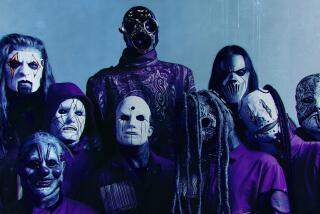Movie review: ‘Sound City’ is homage to recording studio equipment
- Share via
High-spirited, emotional and funny, “Sound City” is, of all things, a mash note to a machine. Not just any machine, however, but one that helped change the face of rock ‘n’ roll.
That piece of equipment, the Neve 8028 sound board, was the crown jewel of Sound City in Van Nuys, a complete dump of a recording studio whose unkempt ambience and warehouse complex location didn’t stop it from turning out more than 100 gold and platinum records, including epochal work by Neil Young, Tom Petty, Pat Benatar, Cheap Trick, Rage Against the Machine, Fleetwood Mac and Nine Inch Nails.
“Sound City” the movie wouldn’t exist if director-rocker Dave Grohl of Foo Fighters hadn’t shown up there in 1991 with his Nirvana band mates to record their groundbreaking “Nevermind” album. “We were just kids with nothing to lose,” he says in the film’s opening voice-over. “We had no idea that the next 16 days would change our world forever.”
Because of Grohl’s rock star status, he’s been able to convince an impressive number of celebrated musicians to sit down for on-camera interviews, including Young, Petty, John Fogerty, Trent Reznor, Stevie Nicks and Rick Springfield.
But because grungy Sound City was the kind of place it was — Barry Manilow says it was “more family than any studio I’ve ever been in” — some of the film’s most memorable stories involve less celebrated folks like unflappable studio managers Paula Salvatore and Shivaun O’Brien, ace producer Keith Olsen and co-owner Tom Skeeter, who genially insists he was only in it for the money.
The film’s best stories cluster around the studio’s most celebrated event, its central place in the formation of Fleetwood Mac.
Buckingham Nicks, created by the romantically involved duo of Lindsey Buckingham and Stevie Nicks, had been the first group to record at Sound City, and when Mick Fleetwood came to the Van Nuys locale looking for a place to record, he heard one of their tracks. Fleetwood thought of Buckingham when he needed a new guitarist and was told, “If you take him, you’ll have to take his girlfriend, too.” He agreed, and in 1975 the revived group recorded at Sound City.
A bit uncertain about the new sound, remembers producer Olsen in one of the film’s many tart interviews, was band member John McVie. “He said, ‘It’s a little far from the blues.’ I told him, ‘It’s a lot closer to the bank.”
It was the determination of Skeeter and co-owner Joe Gottfried to attract top bands that led to the purchase of the sound board in 1973. Designed by Rupert Neve, now in his 80s and interviewed in the film, it was one of only four in the world and the only one custom-ordered. Skeeter remembers that it cost $75,000 at a time when he bought his house in nearby Toluca Lake for half that amount.
“Sound City” goes to some lengths to explain why the Neve is so good at what it does, emphasizing how expert it is in recording the human voice and the drum tracks that are central to rock success. Guitars sound pretty much the same everywhere, says famed producer Rick Rubin, but drums change from room to room, and the sound at Sound City was among the best.
The film (which was written by Mark Monroe and edited by Paul Crowder) is also an education in how the music business works, which is not always in the warmest, most humane manner. Being a producer, for instance, is described by Olsen as “getting creativity onto tape in a way that is accessible to the marketplace.”
The most unexpectedly emotional parts of “Sound City” involve Springfield breaking into tears as he talks about his regrets at the way he handled his rupture with Sound City partner Gottfried, one of the men most responsible for his success.
“Sound City” also goes into fascinating detail about how the change from analog recording on two-inch tape (the studio’s bread and butter) to the digital way of doing things was the death knell for the Van Nuys establishment.
While Neve technology had made its success possible, the rise of easy-to-use Pro Tools equipment trumped their advantages and led Sound City to close its doors and sell its legendary console to Grohl, who moved it down the road to his own Studio 606.
That purchase prompted Grohl to consider a 12-minute short about the Neve for the Web, which morphed into this genial feature. “Sound City’s” final half hour, which features Grohl jamming with other musicians, including Paul McCartney, for a forthcoming album tribute to the Neve, is less involving than what has come before. But the filmmaker cares so much about this board of boards that it’s hard to begrudge him this pleasure.
PHOTOS AND MORE
VIDEO: The making of ‘Argo,’ ‘Les Miz’ and more
ENVELOPE: The latest awards buzz
PHOTOS: NC-17 movies: Ratings explained
More to Read
Only good movies
Get the Indie Focus newsletter, Mark Olsen's weekly guide to the world of cinema.
You may occasionally receive promotional content from the Los Angeles Times.











